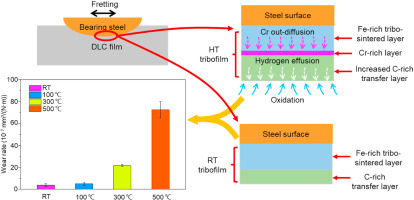Abstract
Diamond -like carbon (DLC) films are capable of offering low friction coefficient and high wear resistance when rubbed in both dry and lubricated interfaces. However, the inherent mechanisms governing fretting wear in DLC films with temperature are still not well comprehended. Herein, atomic -scale analysis was conducted to unveil the relationship between interfacial tribofilms and the fretting wear behaviors. The results emphasize the determining role of the interaction between the tribo-sintered tribofilms and the transferred carbon tribofilms, as well as the structural evolution in the DLC film with temperature. The room temperature (RT) fretting experiment establishes a bilayer nanostructured tribofilm with a C -rich transfer layer on a Fe -rich tribo-sintered layer. As the fretting temperature elevates the graphitization degree of the tribofilms exacerbates, surface oxidation and hydrogen effusion arise in the DLC film, resulting in higher friction coefficients and wear rates. Chromium outward diffusion at 500 degrees C establishes a Cr-rich interlayer in the tribofilm, which forms interfacial chromiumcarbon bonds, promotes adhesive carbon transfer, and leads to the sharp increase of the friction force and wear rate. These findings provide new insights into the fretting wear mechanisms, and provide guidance for the application of DLC films in elevated -temperature fretting scenarios such as aero-engines tenon and spline connections.

Keywords Plus:CHEMICAL MOLECULAR-DYNAMICS,TA-C COATINGS,FRICTION BEHAVIOR
Published in CARBO,Volume 226;10.1016/j.carbon.2024.119217,JUN 2024


